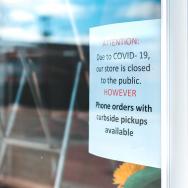Launched early this month, the federal government’s Paycheck Protection Program initially allotted $349 billion to cover approximately eight weeks of primarily employee costs—including some funds for utilities, rent, and mortgage interest. However, by April 16, the fund was depleted.
Congress has now approved an additional $310 billion for the program, bringing the total to about $660 billion. This begs the question: How much could businesses actually request?
According to University of Chicago Booth School of Business scholars John Barrios and Michael Minnis, the ultimate tally could reach $730 billion or more. Still, they point out that trying to estimate total requests by small businesses is not straightforward. The estimate requires two parameters: How much payroll is eligible? And how many firms representing that payroll will actually apply? Uncertainty surrounds both parameters.

“Congress’s decision to increase the pool of funds for the PPP to $660 billion, will get it closer to sufficiently funding application requests, mitigating the problems of the ‘first-come, first-served’ design,” said Minnis, whose research focuses on accounting and investment. “Thus, many small businesses that were unable to get their applications initially processed will have their requests fulfilled in the next phase. How many will depend crucially on several assumptions.”
First, consider estimating eligible payroll. This requires both a set of rules dictating which businesses are eligible and data about the distribution of small businesses. While the U.S. Treasury and the Small Business Administration have provided the rules for eligibility, detailed data covering small businesses is generally more difficult to obtain. The overwhelming majority of these businesses are private and do not report their financials.
To make their estimate, the authors relied on the U.S. Census Bureau’s Statistics of U.S. Businesses data set, which reports aggregate payroll by business size, and the IRS’s Statistics of Income, which reports data for sole proprietors. Still, this data is far from perfect because one cannot account for critical issues such as affiliation status (e.g., cross-ownership of companies and subsidiaries); the $100,000 per employee wage limit; or the $10 million per firm loan limit. Moreover, the data do not provide employee benefits, which also have to be estimated.
Second, trying to discern which eligible businesses apply requires its own set of assumptions. Just a few of the many wide-ranging variables include: Will frustration from the first round reduce application intensity in the second round? Alternatively, will applicants actually apply more intensively since they have seen so many others apply?
Firms also change their behavior in reaction to government policy, the authors stressed. Have companies found ways to game the system, such as sidestepping affiliation rules? What about sole proprietors? These are individuals who file Schedule C tax forms—but for at least some, the filings represent sources of incidental or supplementary income. Those individuals may be less likely to apply for PPP funds if they can rely on a separate source of primary income.
One more potentially important variable could also come into play: On April 23, the Treasury added to their FAQ that “all borrowers must assess their economic need for a PPP loan.” This came in response to the news that some first-round funds had gone to public companies—some of which are keeping the loans despite public backlash. Crucially, this information was revealed through the public disclosure requirements of the SEC; those requirements do not apply to private companies, which vastly outnumber public companies.

So how will compliance of the “economic need” be assessed for the private companies without public disclosure requirements? A possible solution is to emphasize up front to all recipients that information from loan applications (including company name, loan amount and bank) will be made public. This idea is not new: The SBA’s 7(a) loan program already makes application information available. If all applicants know that their application will be disclosed ex-post, this will affect their ex-ante behavior—and potentially allow small businesses who genuinely need the funds to get them.
“Transparency could be critical to affecting applicant behavior,” said Barrios, an expert on labor economics. “If disclosure affects applicant behavior, this could help the funds get allocated to the firms needing it the most.”
Minnis and Barrios developed the PPP calculation tool in collaboration with Petro Lisowsky of Boston University and William Minnis of Eastern Illinois University. The tool is available online, allowing you to make your own assumptions and calculations.
—This research is featured as part of a special project by the Becker Friedman Institute of Economics that highlights a number of new economic facts about COVID-19.









